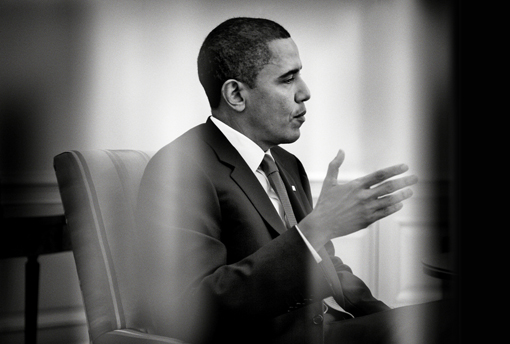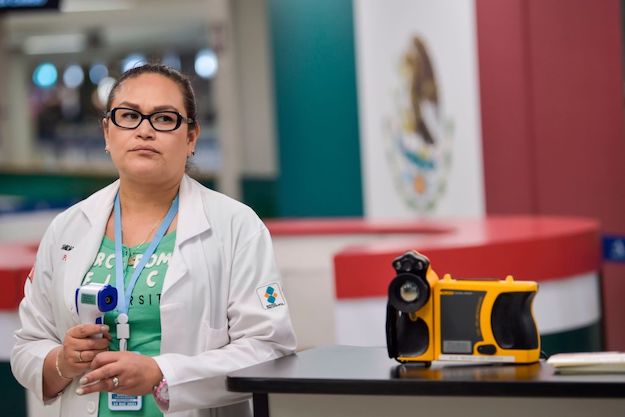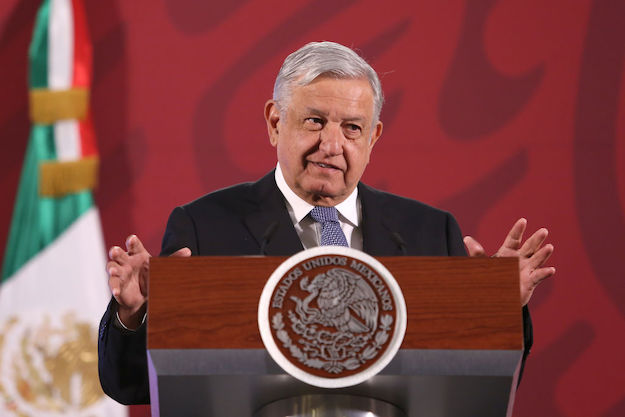On the eve of his sixth trip to Latin America and the Caribbean, President Barack Obama agreed to an interview with Americas Quarterly Editor-in-Chief Christopher Sabatini about his May 2-4 visit to Mexico and Costa Rica. President Obama is using the occasion of his trip to meet with the new Mexican President Enrique Peña Nieto and Costa Rican President Laura Chinchilla, and, while in Costa Rica, he will also meet with the other presidents of Central America.
Given the close economic, political, security, and personal relations between the United States, Mexico and Central America, a number of issues will be on the table. Among them will be the security and narcotics-related crime in Mexico and Central America and U.S. drug policy, the U.S.’s trade agenda with the region, the challenges of social exclusion and economic growth, and—of course—comprehensive immigration reform in the United States. In this wide-ranging interview, President Obama touches on all these issues and discusses his overall views of the region.
Lea una versión en español aquí.
 This will be your sixth trip to the region, and while you are only visiting Mexico and Costa Rica, how does this trip fit into your administration’s relationship with the hemisphere and how the region relates to the U.S.’s broader global agenda and interests?
This will be your sixth trip to the region, and while you are only visiting Mexico and Costa Rica, how does this trip fit into your administration’s relationship with the hemisphere and how the region relates to the U.S.’s broader global agenda and interests?
 I see my trip as another opportunity to highlight the incredible progress across this dynamic region and the critical role the region plays in advancing global prosperity and security. As I’ve said on my previous visits to the region, I see this as a moment of great promise. Today, almost all the people of the Americas live in democracies. Latin America has some of the world’s fastest-growing economies. Across the region, tens of millions have escaped poverty and entered the middle class. More nations are stepping up and contributing to regional and global security.
I see my trip as another opportunity to highlight the incredible progress across this dynamic region and the critical role the region plays in advancing global prosperity and security. As I’ve said on my previous visits to the region, I see this as a moment of great promise. Today, almost all the people of the Americas live in democracies. Latin America has some of the world’s fastest-growing economies. Across the region, tens of millions have escaped poverty and entered the middle class. More nations are stepping up and contributing to regional and global security.
All this creates new opportunities for partnerships among our countries—equal partnerships based on mutual interest and mutual respect where our nations focus on improving the lives of our citizens. This includes the tens of millions of Hispanics in the United States, who make extraordinary contributions to our country. In my first term, we increased trade and investment, deepened our security cooperation to protect our citizens, launched new economic and clean energy partnerships, stood up for human rights, and expanded exchanges between our peoples, including our youth.
My trip will be a chance to sustain this momentum in my second term. Mexico is one of our largest trading partners and the second largest market for U.S. exports, but I’m convinced there’s even more we can do together. So I’ll be discussing with President Peña Nieto how we can continue to reduce barriers to trade and investment, create even more jobs for our people and make our economies even more competitive in the global economy.
In Costa Rica, I look forward to meeting with President Chinchilla and highlighting Costa Rica’s success in making tough political choices that are building the foundation for economic growth and prosperity. My meeting with the leaders from across Central America and the Dominican Republic will be an opportunity for me to reaffirm the commitment of the United States to economic development and integration of Central America. Ultimately, that’s the only way we’re going to meet shared challenges, such as the drug cartels and income inequality.
 Mr. President, you will be traveling to a region that has a huge stake in the U.S. immigration debate currently in Congress. Of course, comprehensive immigration reform is a U.S. domestic issue, but the formal channels that the U.S. provides for foreign citizens to come to the U.S. and how the U.S. deals with (and talks about) immigrants—authorized or unauthorized—deeply affects our relations with those sending countries. Do you feel you can promise something to those leaders you will be meeting with? If so, what will you say to them?
Mr. President, you will be traveling to a region that has a huge stake in the U.S. immigration debate currently in Congress. Of course, comprehensive immigration reform is a U.S. domestic issue, but the formal channels that the U.S. provides for foreign citizens to come to the U.S. and how the U.S. deals with (and talks about) immigrants—authorized or unauthorized—deeply affects our relations with those sending countries. Do you feel you can promise something to those leaders you will be meeting with? If so, what will you say to them?
 On my trip I’ll tell my foreign counterparts the same thing I’ve been telling folks back in the United States—that commonsense immigration reform is one of my top priorities, that we need to get it done, and that I’m optimistic we can.
On my trip I’ll tell my foreign counterparts the same thing I’ve been telling folks back in the United States—that commonsense immigration reform is one of my top priorities, that we need to get it done, and that I’m optimistic we can.
I was proud that we lifted the cloud of deportation from young people brought to the United States as children who have come to be called DREAMERS. But that’s no substitute for permanent reforms to the law. We need to fix our broken immigration system to make sure that every business and every worker in United States is playing by the same set of rules. After all, it’s just not sustainable to have 11 million undocumented immigrants from all over the world who are living in the United States. Like the rest of us, they work hard to provide for their families. They make tremendous contributions to our country and our economy. And their status needs to be resolved in a way that’s consistent with our heritage as both a nation of laws and a nation of immigrants.
The bipartisan comprehensive immigration reform bill introduced in the Senate represents a compromise, and no one will get everything they want, including me. But it is largely consistent with the principles that I have repeatedly laid out. We need to continue to strengthen security at our borders and hold employers more accountable if they knowingly hire undocumented workers. We need to provide a pathway to earned citizenship for undocumented individuals in our country. We need to modernize our legal immigration system so that we’re able to reunite families and attract the highly-skilled entrepreneurs and engineers who will help create good paying jobs and grow our economy. I’ll continue to do whatever it takes to make sure that we pass bipartisan commonsense immigration reform as soon as possible, and I look forward to signing it into law.
 Last year, the Administration advocated for (and achieved) the inclusion of its NAFTA partners in the talks for the Trans-Pacific Partnership (TPP). What do you think TPP will mean for NAFTA, the broader region and the global economy?
Last year, the Administration advocated for (and achieved) the inclusion of its NAFTA partners in the talks for the Trans-Pacific Partnership (TPP). What do you think TPP will mean for NAFTA, the broader region and the global economy?
 I was very pleased that Mexico and Canada joined the negotiations on the Trans-Pacific Partnership because it means even more opportunities for the trade that creates high-paying jobs in all our countries. Our annual trade with Mexico and Canada surpassed one trillion dollars in 2011, and much of this involves the “co-production” of goods made in one country with components from another one of our countries. And as Mexico pursues important structural reforms, our economic interdependence will only increase.
I was very pleased that Mexico and Canada joined the negotiations on the Trans-Pacific Partnership because it means even more opportunities for the trade that creates high-paying jobs in all our countries. Our annual trade with Mexico and Canada surpassed one trillion dollars in 2011, and much of this involves the “co-production” of goods made in one country with components from another one of our countries. And as Mexico pursues important structural reforms, our economic interdependence will only increase.
We intend to complete the TPP negotiations by the end of this year. So we continue to work with Mexico and Canada toward achieving a high-standards agreement that will go beyond the commitments in NAFTA. The rewards would be substantial for all our countries—greater access for our exports to some of the world’s fastest-growing economies which together represent a $1.4 trillion trading relationship.
More broadly, TPP is one part our comprehensive trade agenda. We are now implementing our new trade agreements with Colombia, Panama and Korea. Our new Interagency Trade Enforcement Center is ensuring that trade is free and fair. And as I announced in my State of the Union address, we are in talks with the European Union on a comprehensive Transatlantic Trade and Investment Partnership. Taken together these initiatives represent an ambitious effort to open new markets and expand the trade that supports millions of jobs in our countries.
 Energy is one of the agenda items on your trip. One of the topics that came out of the last Summit of the Americas in Cartagena was the development of intra-regional electricity grids. Yet, there’s been little apparent progress on that front—a reflection in part of the complicated regulatory and land use issues as well as the stakeholders involved. What do you hope to do on this trip to push forward the issue?
Energy is one of the agenda items on your trip. One of the topics that came out of the last Summit of the Americas in Cartagena was the development of intra-regional electricity grids. Yet, there’s been little apparent progress on that front—a reflection in part of the complicated regulatory and land use issues as well as the stakeholders involved. What do you hope to do on this trip to push forward the issue?
 We announced the Connecting the Americas 2022 initiative in cooperation with Colombia in Cartagena last year because we believe that connecting the citizens of our hemisphere to reliable, clean and affordable electricity is critical to our shared prosperity and our economic competitiveness as a region. Keep in mind that we’re only one year into this decade-long effort. I plan to discuss this and related energy initiatives when I meet with the leaders of Central America, where energy costs are two and three times as high as in the United States.
We announced the Connecting the Americas 2022 initiative in cooperation with Colombia in Cartagena last year because we believe that connecting the citizens of our hemisphere to reliable, clean and affordable electricity is critical to our shared prosperity and our economic competitiveness as a region. Keep in mind that we’re only one year into this decade-long effort. I plan to discuss this and related energy initiatives when I meet with the leaders of Central America, where energy costs are two and three times as high as in the United States.
At the same time, the electricity market is only one part of the larger energy picture in the Americas, and our region is playing a growing role in global energy security. Our hemisphere produces one quarter of the world’s oil, almost one-third of its natural gas, nearly 30 percent of global electricity, and we are endowed with abundant renewable energy sources. The United States, Canada, Brazil and Colombia are all harnessing new technologies to develop these resources, and the possibilities for cooperation are enormous.
That’s why in 2009 I called on the region to come together under the Energy and Climate Partnership of the Americas, so we could meet out energy and climate goals together. I’m proud of the work we’ve done so far on ECPA, which has encouraged voluntary partnerships between governments, Inter-American organizations, private industry, and civil society. Working together, we’re pursuing initiatives on renewable energy, energy efficiency, cleaner and more efficient use of fossil fuels, and mitigating the effects of climate change. These are the kind of transnational challenges we can only meet together.
 Two years ago, Mexico pledged to work with the United States in addressing security concerns in Central America. What has happened in that effort since and what do you hope to discuss with the Central American leaders in Costa Rica on the topic of crime and narcotics trafficking in Central America and its effects on security and the integrity of governments in the region?
Two years ago, Mexico pledged to work with the United States in addressing security concerns in Central America. What has happened in that effort since and what do you hope to discuss with the Central American leaders in Costa Rica on the topic of crime and narcotics trafficking in Central America and its effects on security and the integrity of governments in the region?
 I’m grateful that Mexico, Canada and Colombia have joined us in partnering to help the nations of Central America confront the urgent threats to the security of their citizens. This is another example of nations across the region coming together to address a challenge that none of us can meet alone. For our part, the United States has contributed nearly $500 million since 2008 through the Central American Regional Security Initiative to programs aimed at improving security conditions.
I’m grateful that Mexico, Canada and Colombia have joined us in partnering to help the nations of Central America confront the urgent threats to the security of their citizens. This is another example of nations across the region coming together to address a challenge that none of us can meet alone. For our part, the United States has contributed nearly $500 million since 2008 through the Central American Regional Security Initiative to programs aimed at improving security conditions.
During my meeting in Costa Rica with leaders from across the region, I’ll reaffirm the commitment of the United States to support these critical initiatives. To their credit, these governments, civil society, and the private sector are all working together to reduce levels of crime and violence, strengthen the capabilities of the police and judiciaries, develop prevention programs for at-risk youth, and strengthen the protection of human rights.
I’ll also encourage our partners to view citizen security in a more holistic way, recognizing that security can only be sustained in communities that have an effective government presence and services, such as well trained police, healthcare, education, and employment opportunities. And given the large number of young people across the region, I’ll emphasize the need for governments to redouble their efforts to address the underlying forces that make youth susceptible to recruitment into criminal gangs and criminal activities. We want these talented young people contributing to communities, not getting pulled into lives of violence and crime.
 You met with President Enrique Peña Nieto in November 27, 2012, at the White House. Many have called on the United States to work more with Mexico as a partner on a number of regional and global issues that are important to the United States, including trade, climate change, and addressing security south of Mexico’s border. Can you explain what you and President Peña Nieto will discuss to collaborate on themes beyond the bi-lateral agenda?
You met with President Enrique Peña Nieto in November 27, 2012, at the White House. Many have called on the United States to work more with Mexico as a partner on a number of regional and global issues that are important to the United States, including trade, climate change, and addressing security south of Mexico’s border. Can you explain what you and President Peña Nieto will discuss to collaborate on themes beyond the bi-lateral agenda?
 I was pleased to welcome President-elect Peña Nieto to the Oval Office shortly after my re-election. As I said that day, his visit was a reflection of the extraordinarily close relationship between our two countries. By virtue of our geography, our enormous trade relationship, and the deep ties among our families, the U.S.-Mexican relationship is like no other in the world.
I was pleased to welcome President-elect Peña Nieto to the Oval Office shortly after my re-election. As I said that day, his visit was a reflection of the extraordinarily close relationship between our two countries. By virtue of our geography, our enormous trade relationship, and the deep ties among our families, the U.S.-Mexican relationship is like no other in the world.
Given Mexico’s growing leadership in the region and on the world stage, we consider Mexico a strategic partner, so I look forward to consulting with President Peña Nieto on a range of issues. As our nations did at the recent OAS Special General Assembly, we’ll continue to stand up for human rights across the region. Building on Mexico’s presidency of the G20 last year, we’ll continue working to sustain the global economic recovery, promote global development and address climate change. I’m especially grateful for Mexico’s contributions to securing nuclear materials and preventing nuclear terrorism.
A main focus of my discussions with President Peña Nieto, however, will be how we can build on our extraordinary economic relationship. Increasingly, our economic partnership is defined, not just by the goods we sell to each other, but by the products we make together. Already, some 40 percent of the products that Mexico exports to the U.S. are made with parts from the U.S. And given Mexico’s rise as a manufacturing hub of the global economy, the possibilities for even greater “co-production” are tremendous. And as we look ahead to realizing the Trans-Pacific Partnership, I think a new era of economic cooperation between our two countries is only just beginning.
You can continue to follow this topic and these themes when, on May 8, Vice President Joe Biden discusses the President’s trip and the administration’s broader policy toward the region at the Council of the Americas Washington Conference.
For background on issues to be covered during Obama’s trip and related articles, go to AQ’s in-depth page.









